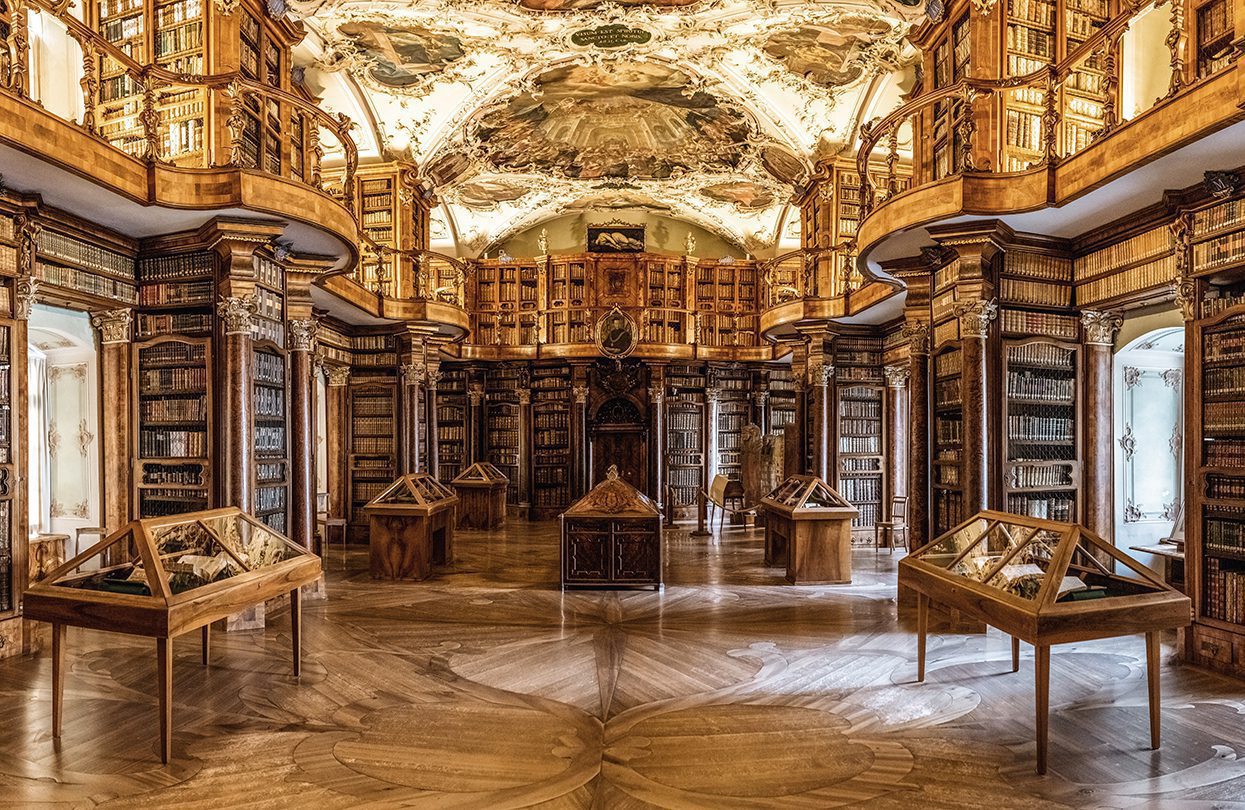Sky-bursting alpine peaks, memorable road trips, and sports to take you out of your comfort zone, plus fantastic food and drink: Switzerland is really bursting with life.
Time-travel
See castles, cathedrals and clock towers on a walk through history
There are two Switzerlands. One is the super-efficient, business-like country renowned for its booming economy and banks. The other is a crossroads of lesser-known stories where Romans, Savoy lords and WW2 fighters left their indelible mark.
Nowhere is such compelling history more apparent than in Bern, Switzerland’s story-riddled capital. The entire core of the 12th-century Old City is worthy of UNESCO status and there is a sense everyone is aware of just how beautiful their medieval map is. To see its most captivating landmarks, don’t miss the Zytglogge Clock Tower, the late-gothic Bern Minster Cathedral, or the renaissance fountains.
From here, it’s an easy hop west by high-speed train to Veytaux and Chateau Chillon, the most visited castle in the country. There’s a perfect marriage of history and environment here and the pomp on display encourages Game of Thrones-style discovery. There are great halls and courtyards, accounts of the Counts of Savoy who controlled the fort and a moat, arsenal and prison to explore. All of this is backed by the glimmer of surrounding Lake Geneva and mountains of rock, ice and snow in the far distance.
Elsewhere, it’s not too hard to slip farther back in time. Once the capital of Roman Helvetia, the town of Avenches has a fully-functioning Roman amphitheatre, which hosts an opera festival, while the landmark Abbey of Saint Gall in picture-postcard St Gallen to the east lets you wander through living history. It has a rococo library and one of the world’s most beautiful book collections. At Sasso San Gottardo in Ticino, Switzerland’s Italian-speaking canton, history is far better hidden. Here you’ll find a former secret military bunker built in WW2, nowadays open as an intriguing museum.
Too much to take in? Focus on Zurich instead and spend a few hours casually dipping in and out of the collection at the Swiss National Museum. With more than 840,000 artifacts, there are dozens of national treasures, as well as galleries dedicated to some of Switzerland’s favourite pursuits — sledging and making watches.
Road trip
The Grand Tour of Switzerland; an astounding roadtrip through the Alps
While meandering through a maze of mountain passes, cruising along quiet alpine lakes, and charming timber houses, endless stretches of asphalt offer a look inside the pure Swiss soul. A marvellous road trip route The Grand Tour of Switzerland takes you on a thrilling ride along with alpine beauty.
The Grand Tour of Switzerland contains over 1000 miles of panoramic roads and 12 UNESCO World Heritage sites, making it a road trip of mythic proportions. Not only will you witness some surreal scenery and fairytale-like towns like Geneva and Lucerne, this experience also comes with the comforts of soothing Swiss delicacies. At 51 designated outlets along the route you can collect your Grand Tour Snack-Box; a picnic package of your dreams with Swiss chocolate, cheese, and fruit juices freshly squeezed from the yards on the country’s rolling hills.
To promote eco-friendly travelling through the Alps, the architects of this route have installed enough charging stations to complete the entire Grand Tour by e-car. Once the car is filled up and it’s time to hit the high roads again, you won’t get lost thanks to the GPX maps of the Grand Tour, downloadable for any navigation device. This road trip enables travellers to experience a staggering and wild adventure, without losing the comforts of a ritzy holiday.
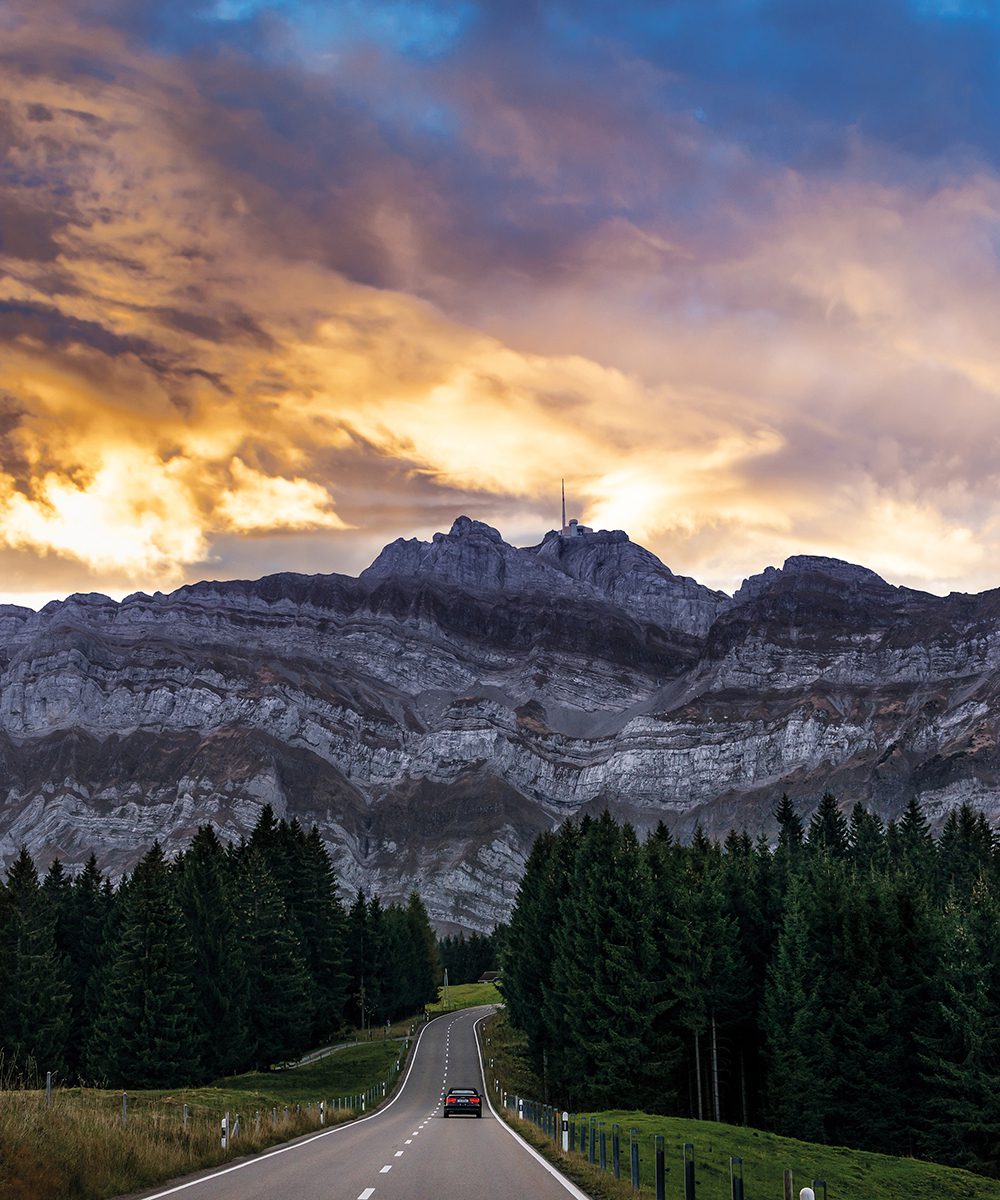
The sphinx on the Jungfraujoch (3571m). Inside is the highest railway station in Europe, hence the nickname ‘Top of Europe’, Switzerland Tourism – Ivo Scholz
The Grand Tour leads to several fascinating cities. Zurich with its lush wellness heaven The Dolder Grand Spa, Geneva with boat tours on its pristine lake and an exquisite private lunch under the shade of vines, and Basel with its rich art museums and medieval architecture. The perfectly planned routes, signages and stops translates to a carefree drive along Europe’s most beautiful and scenic roads. For more information : www.myswitzerland.com
Alpine highs
From tennis to ice hockey to skiing, the Swiss know more than most about how to keep active
Roger Federer. The Olympic Museum. FIFA. And let’s not forget the Spengler Cup, the world’s oldest invitational ice hockey tournament, or the Bol d’Or Mirabaud, the world’s largest inland lake regatta. These are just some of the names and events that underline Switzerland’s obsession with all things sport.
Begin by swotting-up on history at the Olympic Museum in Lausanne. As the International Olympic Committee is based in the city, the museum provides a nuts and bolts overview of the competition’s history, including a hall dedicated to Olympic torches and enough sports memorabilia to fill several stadia. Zurich, meanwhile, is home to the world’s football governing body FIFA and its FIFA World Football Museum presents the highs and lows of the world’s most popular sport in high-tech glory. For the ultimate Instagram post, grab a selfie with its most famous exhibit — the original World Cup trophy.
Dominating sporting life are the seasons. While lakes become summer playgrounds for sailors and parks give over to the de facto national sport tennis (blame Federer for that one), the mountains amp up the drama in winter. There are scores of ski resorts, thousands of kilometres of pistes and Nordic tracks to test yourself on. For off-piste powder turns, consider mega resorts Verbier, Engelberg, Davos or Laax, while Zermatt, St Moritz and Gstaad are favourites for another sport entirely — window shopping at luxury boutiques.
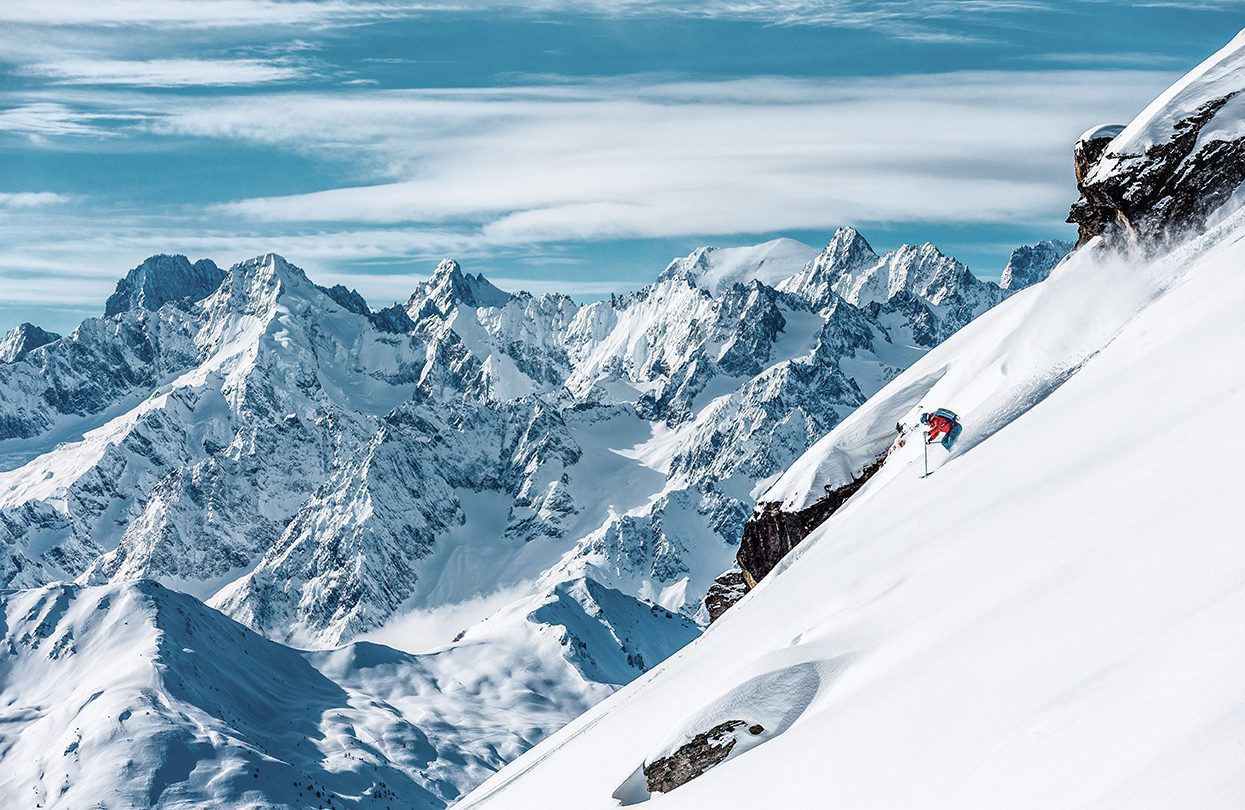
A Freerider en route in the Verbier region, Switzerland Tourism – Grant Gunderson
Those with an eye on something a little different might want to spectate at a boisterous ‘schwingen’ competition. Native to Alpine Switzerland, it meshes wrestling with traditional sumo, turning farmers into folk heroes as they try and knock their opponent out from within a sawdust circle.
Into the mountains
By gondola, cable car or funicular, Switzerland can transport you to an entirely different world
Thrills, spills and high Alpine chills: Switzerland has some of the world’s most fabulous mountain rides and every year new projects take visitors into new frontiers. Many are record-breaking modes of transport, but they all share one thing in common: whether big or small, they are all mean feats of engineering.
One of the greatest journeys is the seemingly-impossible funicular ride through the heart of the Jungfrau to the “Top of Europe’ panorama at 3,454m. Take the train from Interlaken Ost station, before climbing to Kleine Scheidegg ahead of a ride on the hourly Jungfrau Railway. If the ascent into a world of rock, snow and ice doesn’t steal your breath, consider the train was first built in 1912 and you’ll disembark at the highest rail station in Europe.
For a bird’s eye view, the nearby 6km Grindelwald-Männlichen Gondola Cableway is one of the world’s longest cable-car rides and offers a face-on view of three bumper-to-bumper Bernese peaks: the Eiger, Jungfrau and Mönch. Also consider Appenzell’s Ebenalp air tram — it affords access to consistent thermals for experienced paragliders and is a mesmerising spectacle for those who prefer to keep their feet on the ground. On summer weekends, the skies fill with coloured chutes and high fliers.
The Matterhorn Express is another record breaker in far-flung Zermatt. Not only is it the world’s highest 3S cableway, but by connecting Trockener Steg with the Klein Matterhorn at 3,883m, it deposits you at Europe’s highest cable car station. Needless to say, the Insta-worthy view absorbs dozens of the Alps’ grandest peaks.
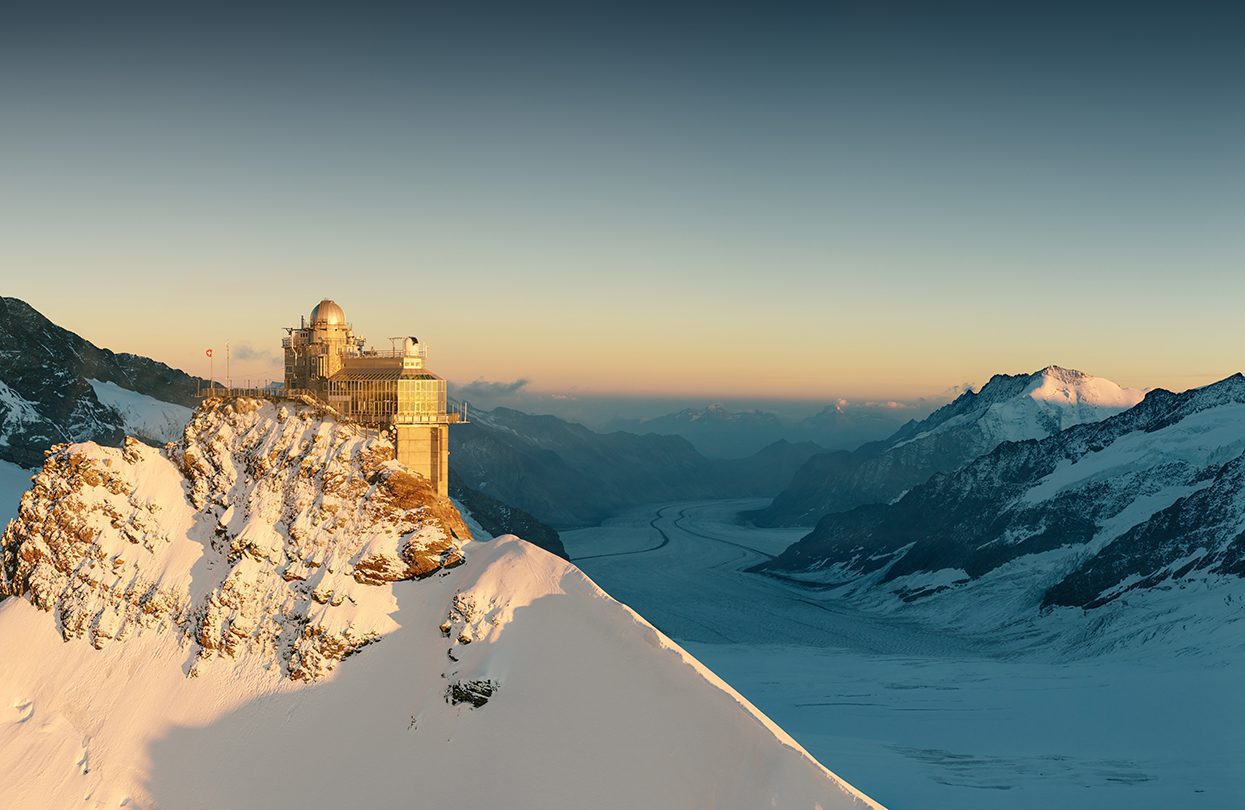
The Sphinx on the Jungfraujoch, Top of Europe, Switzerland Tourism – Sebastien Staub
Finally, no visit to Switzerland is complete without a ride on one of the many ‘Buiräbähnli’, box-size gondolas run by local farmers. With around 40 or so, the Engelberg Valley is renowned for such vintage contraptions, seeing them first introduced to help bring supplies from the valley floor up to the loftiest of Alpine peaks. There are three cableways to try in the village of Oberrickenbach and one in Wolfenschiessen, making it possible to zig-zag across the river valley without once crossing a road.
A taste of the Mediterranean
With pizza, pasta and lakeside chic, Ticino is the best of Italy in microcosm
Ticino’s prettiest tourist towns Locarno and Ascona make for a fabulous Italian-influenced interlude on any Grand Tour of Switzerland.
Once part of the Roman Empire, Ticino was long a buffer between the Germanic peoples north of the Alps and Italy to the south, only becoming part of the Swiss Confederation in the late-15th century. Today, it feels as Italian as nearby Lake Como or Milan, and yet is a little more gentrified and all the better for it.
After exploring the lakeside boutiques and restaurants of Ascona and Locarno (home to the renowned International Film Festival every August), delve deeper into the canton’s rustic heart by discovering its wild canyons and mountains. The Vallemaggia is home to a grappa-clear river, while Valle Verzasca has quiet hamlets, beautiful hiking trails and Europe’s largest bungee-jump. A white-knuckle lunge off the top of the Contra Dam is a rite of passage.
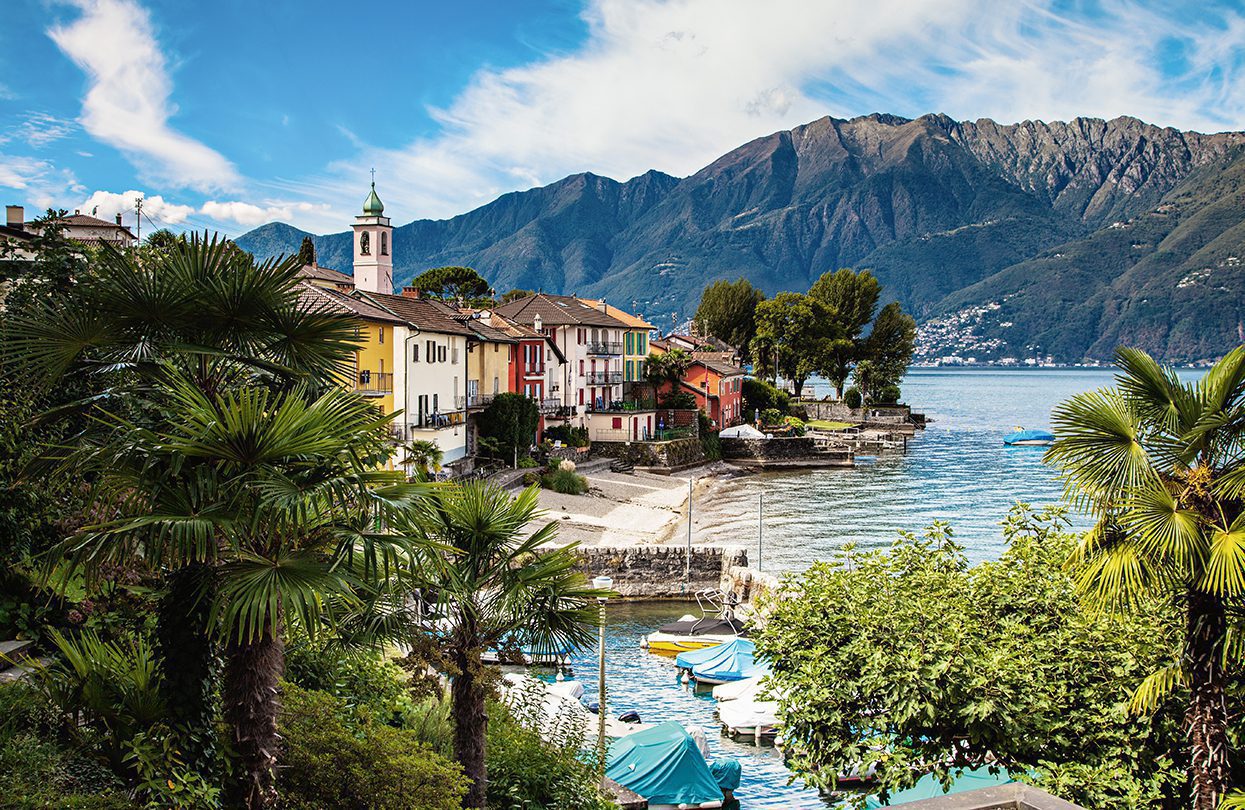
Small harbor with colourful row of houses on Lake Maggiore, Switzerland Tourism – Jan Geerk
Unknown mountain trails provide another compelling reason to follow Ticino’s route less travelled. The Cardada cable car whisks you from Lago Maggiore to within touching distance of the summit of Cimetta and yet combines back country hiking with hospitable restaurants untouched by mass tourism. To the north lies Bellinzona and its three UNESCO-listed grand castles, with turrets, defensive walls and sprawling ramparts. For an Indiana-Jones style family day out, few places in the Alps’ foothills deliver history quite like it.
Time to slow down
Don’t be fooled by Switzerland’s brisk manner— this is a country that equally loves to relax
Picture the scene. A sunlit morning, wisps of clouds floating past a crowd of 3,000m peaks. You take a deep breath and you feel as if you’ve filled your lungs with more than just air — they’re full of opportunity.
It’s a little melodramatic, but this is the Swiss attitude to wellness and as the pioneer of medical tourism, the country teems with luxury spas and medicinal thermal baths.
The big ones to consider are Grand Ragaz and Bad Zurzach, both located in the Rhine Valley and with long traditions as thermal hangouts. At Bad Ragaz, thermal waters bubble up from inside the deep Tamina Gorge, while the town of Bad Zurzach is punctuated with spa resorts, as well as health centres, a medical wellness centre and a rehab clinic.
Check your history books and you’ll learn Davos was the first place in Europe to instigate wellness breaks, prompted by hoteliers opening sanatoria to combat the ill effects of tuberculosis. Today, this story continues anew at the time capsule Schatzalp Hotel in Davos in the shadows of Zauber Berge, or the ‘Magic Mountain’. Originally, it was made famous by German novelist and former guest Thomas Mann.
For a more up-to-date spa escape, check into the multi-million mountaintop Bürgenstock Resort, a project built on a scale Switzerland has never seen before. Spa goers will love the choice of four hotels (purpose-designed with wellness in mind), a cliff-top spa, nine-hole golf course and a dozen restaurants.
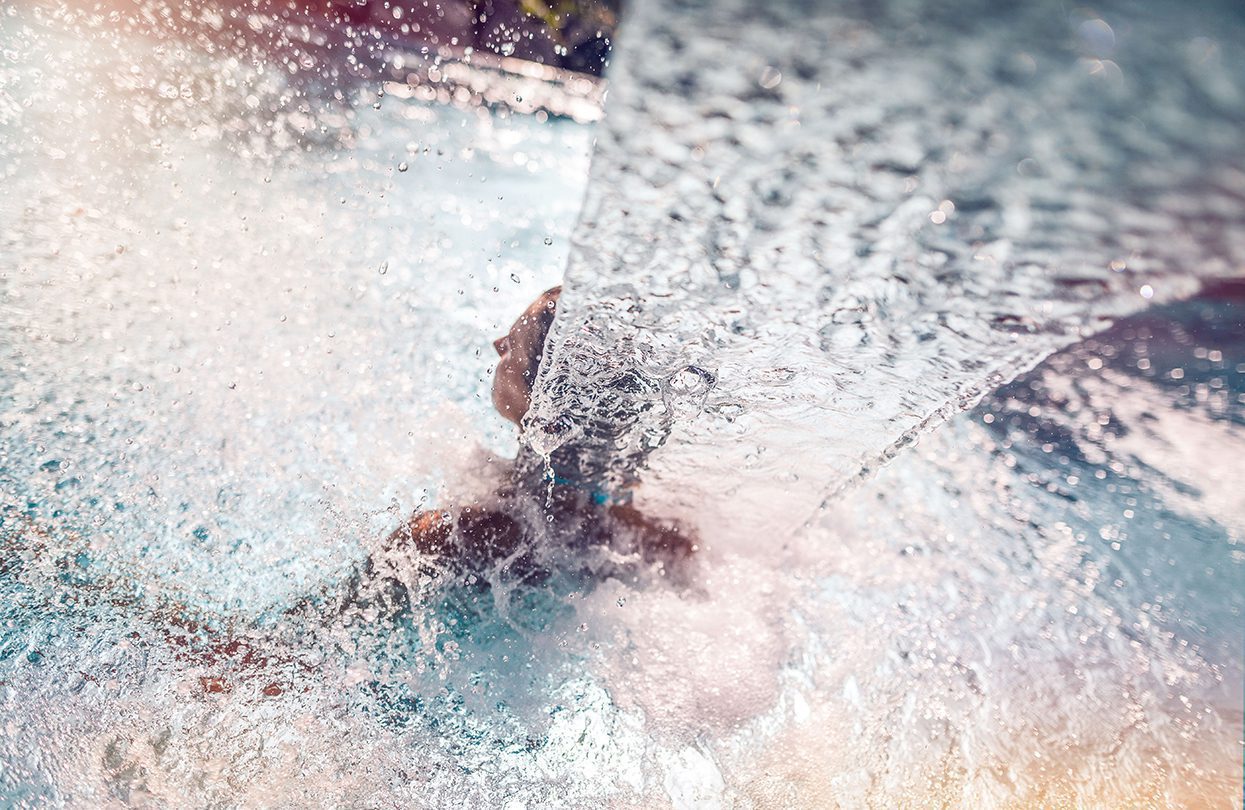
VALAIS – Wellness, Leukerbad, Valais_Wallis Promotion – Pascal Gertschen
Finally, Leukerbad has a mentality that’s more easygoing Mediterranean than efficient Swiss. People here get all wrinkly at the largest thermal spa resort in the Alps, which in real terms means 3.9 million litres of bubbling thermal waters to soak and soothe in. It’s as much of a balm as the mountain air and soul-stirring views.
Clock-watching
Learn about the country’s storied watch salons and manufacturers
You could think of Geneva as a time-pressed lake town. There’s a reason for this: after private banking and investment, watchmaking is still the richest industry in the city.
Look across Lake Geneva and pastel-coloured hotels and houses on the waterfront bear the weight of rooftop billboards listing dozens of manufacturers. Omega, Piaget, Raymond Weil, Tissot, Breitling, Franck Muller, IWC Shaufhassen, Vacheron Constantin, Rolex — they are all there. Indeed, it feels as if every 20 metres you stumble on a watch boutique. For it’s the point of watch shopping and learning about the art of time to find oneself in Geneva.
The most atmospheric place to start is the Patek Philippe Museum. Home to the city’s history of horology, the museum houses more than 200 years of watchmaking heritage and nowadays provides inspiration for the city’s watchmakers, artists, engravers and jewel setters. On display are some of the most complicated timepieces ever made, alongside regal gifts belonging to kings and queens and one of the earliest watches ever manufactured (dating back to 1839). Keep an eye on your own wrist — it’s genuinely impressive how fast time goes while on a tour.
Take a taxi back into the city to window-shop the boutiques on the most enviable address in the city, rue du Rhône. The boulevard crosses the heart of Geneva, following an arrow-straight line and leading to world-famous Gübelin, Switzerland’s most famous watch boutique. Pictures of George Clooney, Nicole Kidman and Leonardo DiCaprio sporting uber-luxe Swiss brands dominate, but you’ll be surprised how easygoing and accessible the salon is to entry-level buyers. Finally, stretch your legs by walking to the world’s largest floral clock, l’horlogefleurie, on the banks of Lake Geneva.
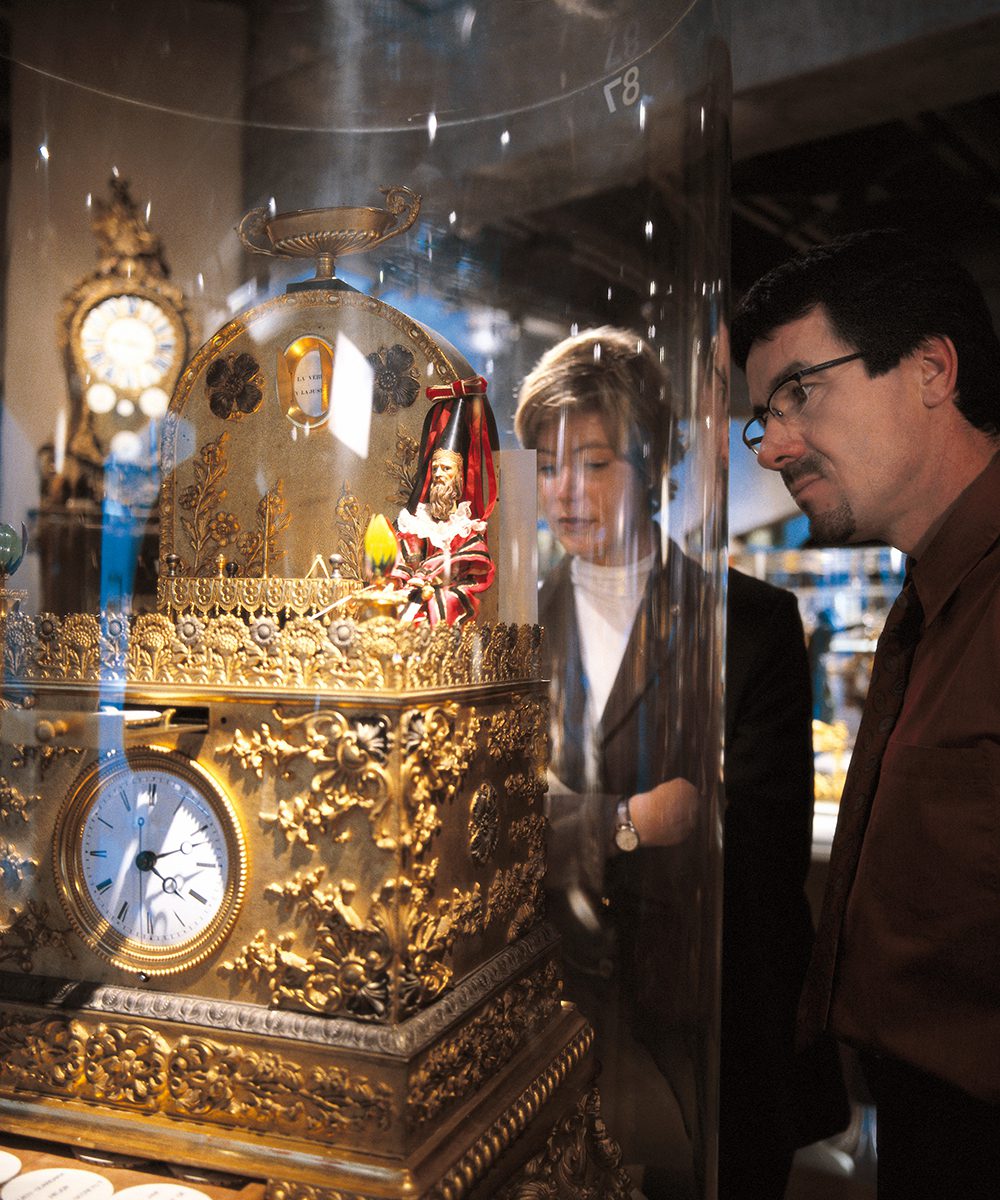
The ‘Musee international d’horlogerie’ in La Chaux- de-Fonds in canton Neuchatel. Pendulum clock with the ‘great magician’, around 1830, Switzerland Tourism – Peter Maurer
Beyond Geneva, Biel is another traditional watch-making stronghold. The Omega Museum in Biel showcases a wowing collection of some 4,000 prized timepieces, while collectors and connoisseurs rave about the insanely-large collection on display at the International Museum of Horology in nearby La Chaux-de-Fonds, north of Neuchâtel. Then there’s the Muséed’Horlogerie du Locle in Château des Monts. A former watchmaking school, it’s housed in a palatial manor house on a sweeping estate. Of course, the prestigious collection that people come to ogle is just as impressive.
One thing to remember. Don’t mention the cuckoo clock. They come from Bavaria in southern Germany and the Swiss don’t much care for the stereotype.
Cheese, chocolate and wine
Meet the artisans on a tasting tour of fromagerie, sweet shops and vineyards
The Swiss won’t let you forget their gift to the world. Namely, milk chocolate, which was invented in the 1880s. But there are plenty more memorable foodie experiences to savour on a calorie-packed tour of the country.
Start with the main event: chocolate. It’s possible to visit dozens of factories and artisan chocolatiers, particularly in Zurich where the spectre of buttoned-down conservatism is forgotten at the city’s playful emporiums. Devote a day to cherry-picking the best handmade truffles and air-brushed candies at the likes of Läderach, Teuscher and ConfiserieHonold, all classic old-time ateliers in the Old Town. There are dozens of others squirreled away, but don’t leave without dropping by Sprüngli for a bag of oozy Truffe de Jours, chocolate truffles of the day.
The truth is, it’s hard to go wrong. Across the country, you can unearth sweet treats at Maison Cailler’s historic Broc chocolate factory near Gruyères, or savour a nostril-tingling excursion at the Chocolarium of Maestrani in Flawil, the only factory in Switzerland that lets you onto the production floor.
Cheese in Switzerland takes some beating, too. From Appenzeller to Emmental to Gruyère, there is plenty to sample. In particular, raclette (grilled cheese) and world-famous fondue (melted cheese) are the results of lifelong obsessions. The idea of exploring the Swiss countryside from farm to farm is a popular one, and many cheesemakers are set-up to cope with the demand. You can meet farmers at the La Maison du Gruyère cheese dairy in Gruyères, while the traditionally-dressed characters at the Appenzeller Cheese Factory in Stein are as unforgettable as the products. If that sounds too much for your midriff, the Emmen Valley Cheese Trail offers self-guided, calorie-burning biking tours.
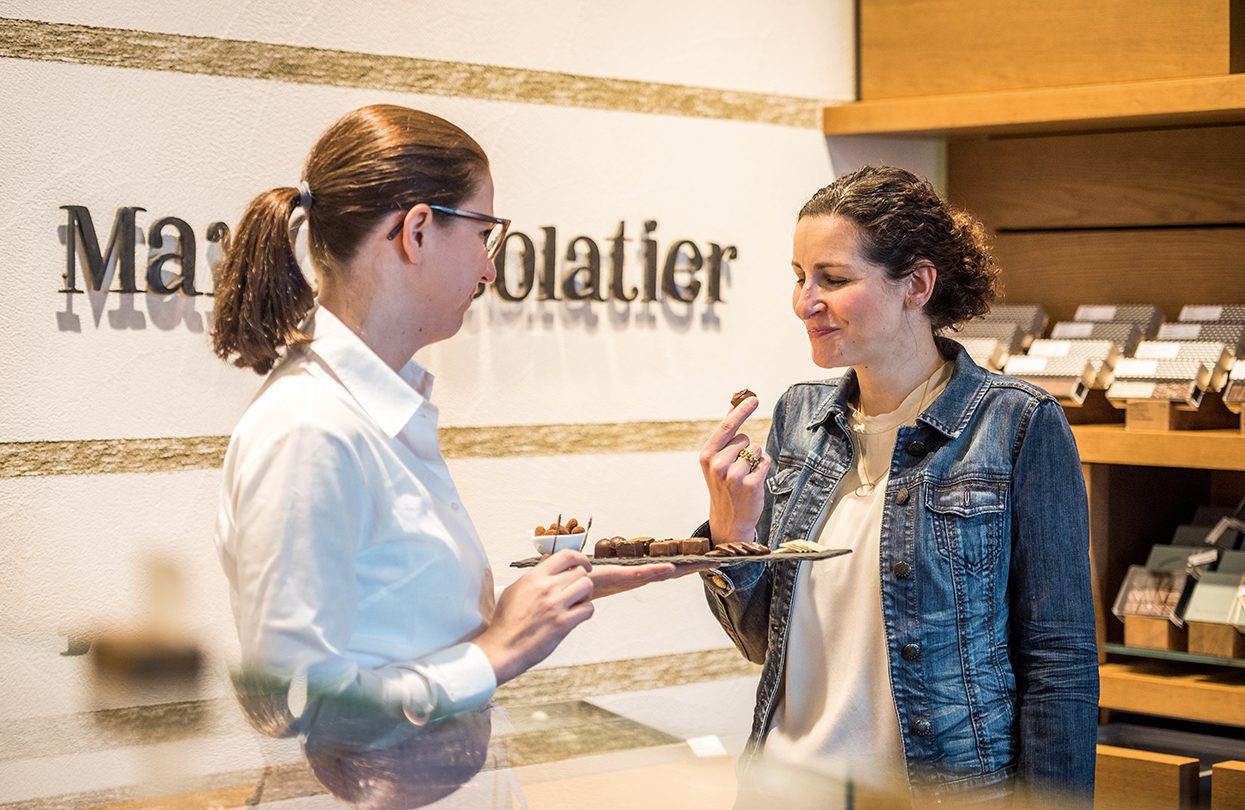
Franziska Buendler at Max Chocolatier in Luzern, Switzerland Tourism – Andre Meier
If one place in particular sums up Switzerland’s attitude to food and drink, it’s the canton of Appenzell, where the air is heavy with the smell of whisky. The reason is BrauereiLocher, a family-run brewery that uses water from the mountains and barley grown at altitude for top-shelf single malts. It’s particularly good and connoisseurs can follow the Appenzeller Whiskytrek, a 27-stop mountain hut tour across the Alpstein massif, where diversely-aged drams are available at each stop. It’s an unlikely marriage of Alpinism and alcohol, if ever there was one.
Screen and page
IMAX-sized peaks and cinematic valleys give Switzerland a starring role
Don’t doubt it: Switzerland is Xanadu for film and fiction fans. Begin a country-wide tour by going to J.R.R Tolkien’s Middle Earth in the heart of the Bernese Oberland. The Lord of the Rings author was so taken by the steep-sided cliffs, grottoes and wild flower forests of Lauterbrunnen when he holidayed here in 1911 that it formed the inspiration for his elvish valleys and troll-filled woods.
Lake Geneva had a similar effect on Frankenstein author Mary Shelley, who stayed on the water’s edge in 1816, and there are plenty of literary threads to pick at in the surrounding area. Amongst these are the statue of Frankenstein’s monster on Geneva’s Plainpalais and Villa Diodati in the village of Veytaux where she once spent the night. Chateau Chillon, meanwhile, was a notable influence on English romanticist Lord Byron, who made the setting for his poem The Prisoner of Chillon.
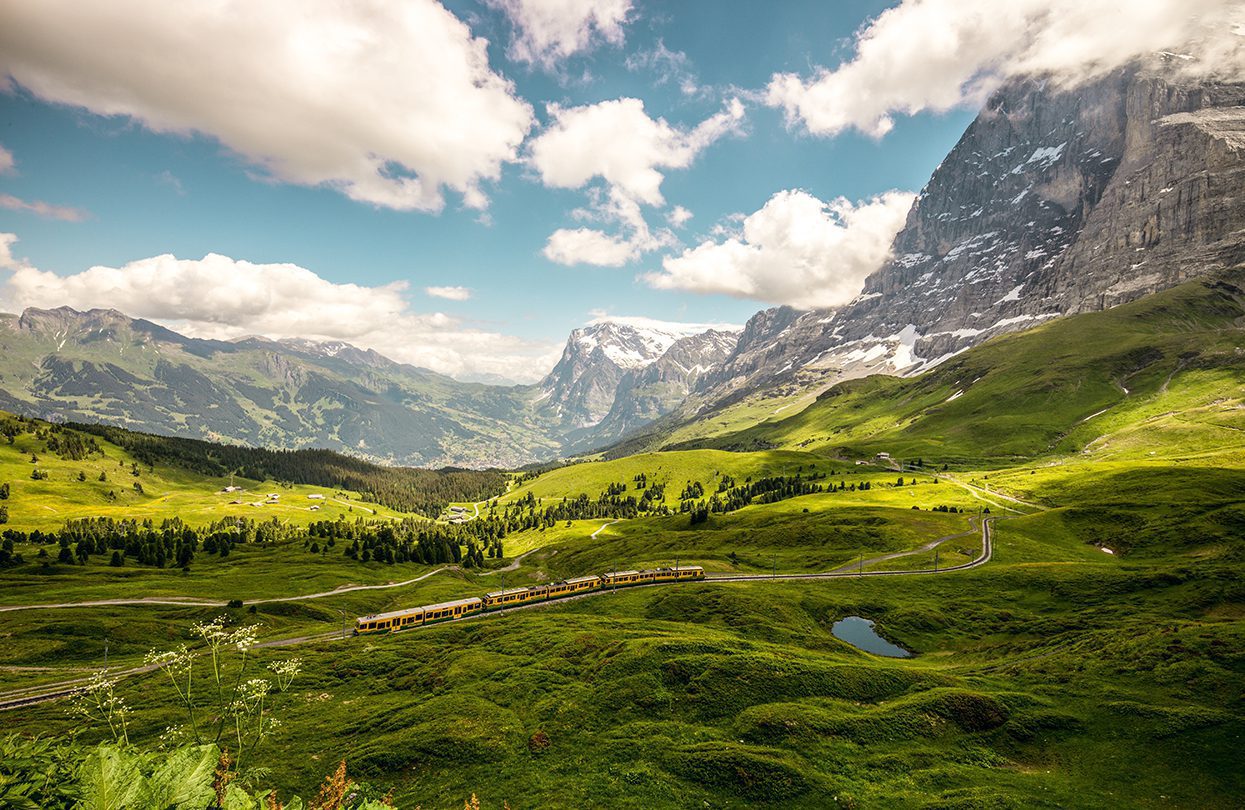
On the Kleine Scheidegg with a view to Grindelwald. The Jungfraubahn in front of the Eiger North Face, Switzerland Tourism
Switzerland does Victorian-era crime-fighting, too, and it’s easy to get lost in the pages of a Sherlock Holmes plot – particularly on a visit to the 120m-high Reichenbach Falls, a short hike from the town of Meiringen. Like J.R.R. Tolkien, Sir Arthur Conan Doyle, the creator of the 221B Baker Street sleuth, holidayed in the Bernese Oberland, finding inspiration in its plunging valleys and cascades. Fans of the books, TV shows and movies will instantly recall the waterfall where Holmes made his last stand, fighting against his nemesis Professor Moriarty. To honour the fallen hero, Meiringen has a statue and museum dedicated to the deerstalker-wearing detective. To fully immerse yourself in the author’s world, you may also fancy travelling farther east to Arosa, squirrelled away amongst a cradle of mountains in Graubunden and once a favoured holiday spot for the Edinburgh-born writer.
The Swiss have a great underlying sense of humour, so it’s small wonder Charlie Chaplin moved to the country, spending his twilight years in the Manoir de Ban in Vevey. Recently, his home and estate have been turned into the immersive Chaplin’s World, where you can learn more about the movie great’s journey through the era of silent comedies. ◼
Subscribe to the latest edition now by clicking here.
© This article was first published in June-July 2019 edition of World Travel Magazine.


